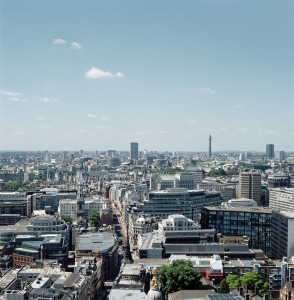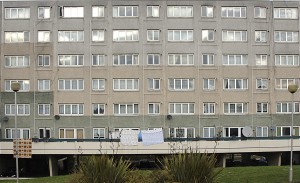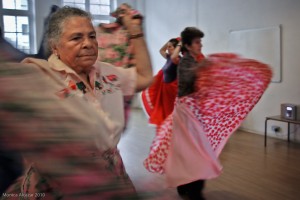 London is seen as being a vibrant multicultural city that attracts and houses people from all over the world. How is this diversity experienced in everyday life though? And how is it that different areas of the same city can have vastly different experiences of diversity despite both having similar levels of immigration?
London is seen as being a vibrant multicultural city that attracts and houses people from all over the world. How is this diversity experienced in everyday life though? And how is it that different areas of the same city can have vastly different experiences of diversity despite both having similar levels of immigration?
The Concordia Discors project aimed to investigate questions like these. Starting in early 2011, in cooperation with universities and research institutes in four other European cities – Barcelona, Turin, Nuremberg and Budapest the research focused on the everyday experiences of getting along at the local level.
 Fieldwork (as described in a previous blog) was conducted in five cities and for each, two inner-city neighbourhoods were selected that are characterised by relatively high levels of ethnic minority and immigrant populations. Please visit the project webpages for further details - http://www.concordiadiscors.eu/
Fieldwork (as described in a previous blog) was conducted in five cities and for each, two inner-city neighbourhoods were selected that are characterised by relatively high levels of ethnic minority and immigrant populations. Please visit the project webpages for further details - http://www.concordiadiscors.eu/
I was involved in the London project and our fieldwork, carried out in Bermondsey and Camberwell in the London Borough of Southwark during much of 2011, was based on interviews with local stakeholders and service providers, as well as with local residents living in selected areas within the two neighbourhoods. Having recently completed the final report for this project, this blog post outlines some of the main conclusions emerging from the fieldwork.
Two very different neighbourhoods
Despite being situated in close proximity, Bermondsey and Camberwell stand out as two very different neighbourhoods in terms of the urban fabric, the social fabric and the nature, magnitude and stability of flows of population. Camberwell has since the 18th century been impacted by different drivers of settlement, ranging from the suburban growth of the early 19th century to different waves of post-WW2 immigration. This has resulted in a heterogeneous urban landscape characterised, historically as well as in the present day, by high levels of socio-economic and ethnic diversity. In contrast, Bermondsey has historically been predominantly a homogeneous and white neighbourhood rooted in extensive local kinship relations, with the majority of livelihoods based on local employment in the docklands and related industries. This has – historically and to a lesser extent in the present day – been expressed in a strong neighbourhood narrative and identity with an explicit them versus us distinction according to territorial markers, but also with racial, and at times racist, connotations.
Socio-economic differentiation
Socio-economic disparities were seen by many as the biggest divide in the two neighbourhoods. This was most pronounced in Bermondsey where the post-industrial redevelopment since the 1980s of the former docklands into expensive housing, attractive due to their proximity to central London, has resulted in a very distinct physical, social and economic delineation between, on one hand, gated communities and, on the other, housing estates in the northern part of Bermondsey. In Camberwell, the socio-economic differentiation between the industrial working classes in northern Camberwell and the middle-classes in southern Camberwell is a characteristic that historically has defined the urban landscape, with well-maintained Georgian terraces contrasting deprived housing estates. The socio-economic differentiation can in both Bermondsey and Camberwell be translated into an overlaying of class with race/ethnicity, as the majority of incomers can be categorised as white and middle-class.
 Access to housing
Access to housing
The availability of housing and the nature of the housing stock in Bermondsey and Camberwell are closely related to the mobility dynamics and intergroup relations. Camberwell is characterised by a very mixed housing stock that includes owner-occupation as well as different types of private and social letting, and the availability of relatively inexpensive housing is one of the factors that have attracted immigrants to Camberwell in the post-WW2 period. The contrast to Bermondsey is striking in that almost the entire housing stock here until the 1980s consisted of social housing. As access to social housing was controlled by the local authorities and Bermondsey up to 1965 was an administrative unit in its own right, local residents would be given priority when allocating social housing. When Bermondsey became part of Southwark Borough, the social housing stock became available to residents from the entire borough, over time also to immigrants and residents of ethnic minority background, and the allocation of social housing remains a very sensitive issue among in particular elderly White British residents in Bermondsey.
Generational divides
It is in part the access to local housing that can be seen as attributing to generational divides along ethnic lines. In Bermondsey this is expressed in a ‘skewed’ demography. The majority of the White British population here are elderly residents. But often their families have moved away, typically into Kent, mainly due to the shortage of affordable housing but often also to avoid inner city schools for the children. This elderly population segment is contrasted by a younger population of immigrants and ethnic minorities, often with children. School census figures, for example, reveal a generational shift from one of inner London’s least ethnically diverse population to a recent picture with White British children in the minority at the bottom of the age scale. In Camberwell, an immigrant destination for much longer than Bermondsey, the proportionate change is much smaller, but the same generational trend has intensified super-diversity to some of the highest levels in Europe.
Conviviality and spaces of encounter
Overall, it was the experience of local residents that the streets of both Bermondsey and Camberwell are characterised by a generally unproblematic everyday negotiation of difference. But the everyday sharing of public space cannot be translated into more than passive coexistence based on a level of public familiarity. As a White British Bermondsey resident put it: ‘There’s no hostility. I think people leave one another to get on with life. It’s [a] passive rather than an active community’. Interaction across ethnic and racial boundaries would typically occur in situations where residents shared a purpose, for example in churches, on some estates, in libraries and schools. Several, mainly female respondents pointed to the school gate as a meeting place as those who went there to hand over or collect their children shared a purpose – as well as, often, identical problems related to schooling and child care. Given the demographics of the two neighbourhoods, however, the school gate is mostly a meeting place of ethnic minority and immigrant parents, as the proportion of white children in local schools is declining sharply.
 Community and participation
Community and participation
The ethnic and racial diversity of Bermondsey and Camberwell is reflected neither in the local community organisations nor in the profile of participants in local community meetings and events. The majority of Bermondsey residents who get involved in activities at the local level are middle-aged and elderly White British residents, typically of working-class background. This concerns events and meetings staged locally as well participation in tenants and residents associations at estate level. Camberwell is similar, though a higher proportion of participating residents in Camberwell are likely to be long-term middle-class residents. In both Bermondsey and Camberwell, residents of immigrant and ethnic minority background were less likely to get involved in civil society platforms at neighbourhood level. For some, in particular residents of West African origin, the church constitutes a much more significant focal point. Though many West African churches are situated locally, in particular in Camberwell, they are not seen as having any particular stake in the local neighbourhood.
In conclusion
In conclusion, it might be worthwhile to reiterate a couple of the most significant findings. One is the socio-economic disparity, increasing in both neighbourhoods, which residents repeatedly pointed to as the most significant divide at neighbourhood level. Class trumps race, so to speak. Another key finding concerns the distinction between Bermondsey, with narratives and practices around community, cohesion and integration still rooted in a distinction between a white, locally rooted (but ageing) Bermondsey population and immigrants from abroad, and Camberwell where there is no residential core with a claim to the history and identity of the neighbourhood.
The final leg of the project, which is still outstanding, is a conference that will be held in Brussels next month. Participants will include researchers from each collaborating university, the wider policy community, as well as stakeholders from the neighbourhoods where fieldwork was carried out. The detailed report, based on findings from the fieldwork carried out in London, will be available on the COMPAS website shortly.